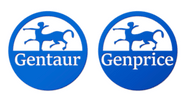Description
SCAND1 Antibody | 25-391 | Gentaur UK, US & Europe Distribution
Host: Rabbit
Reactivity: Human
Homology: N/A
Immunogen: Antibody produced in rabbits immunized with a synthetic peptide corresponding a region of human SCAND1.
Research Area: Transcription, Cell Cycle, Cancer, Apoptosis,
Tested Application: E, WB
Application: SCAND1 antibody can be used for detection of SCAND1 by ELISA at 1:62500. SCAND1 antibody can be used for detection of SCAND1 by western blot at 1 μg/mL, and HRP conjugated secondary antibody should be diluted 1:50, 000 - 100, 000.
Specificiy: N/A
Positive Control 1: Cat. No. 1205 - Jurkat Cell Lysate
Positive Control 2: N/A
Positive Control 3: N/A
Positive Control 4: N/A
Positive Control 5: N/A
Positive Control 6: N/A
Molecular Weight: 19 kDa
Validation: N/A
Isoform: N/A
Purification: Antibody is purified by peptide affinity chromatography method.
Clonality: Polyclonal
Clone: N/A
Isotype: N/A
Conjugate: Unconjugated
Physical State: Liquid
Buffer: Purified antibody supplied in 1x PBS buffer with 0.09% (w/v) sodium azide and 2% sucrose.
Concentration: batch dependent
Storage Condition: For short periods of storage (days) store at 4˚C. For longer periods of storage, store SCAND1 antibody at -20˚C. As with any antibody avoid repeat freeze-thaw cycles.
Alternate Name: SCAND1, RAZ1, SDP1
User Note: Optimal dilutions for each application to be determined by the researcher.
BACKGROUND: The SCAN domain is a highly conserved, leucine-rich motif of approximately 60 aa originally found within a subfamily of zinc finger proteins. This gene belongs to a family of genes that encode an isolated SCAN domain, but no zinc finger motif. Functional studies have established that the SCAN box is a protein interaction domain that mediates both hetero- and homoprotein associations, and maybe involved in regulation of transcriptional activity. Two transcript variants with different 5' UTRs, but encoding the same protein, have been described for this gene. The SCAN domain is a highly conserved, leucine-rich motif of approximately 60 aa originally found within a subfamily of zinc finger proteins. This gene belongs to a family of genes that encode an isolated SCAN domain, but no zinc finger motif. Functional studies have established that the SCAN box is a protein interaction domain that mediates both hetero- and homoprotein associations, and maybe involved in regulation of transcriptional activity. Two transcript variants with different 5' UTRs, but encoding the same protein, have been described for this gene.










